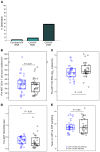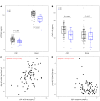Persistent HIV-infected cells in cerebrospinal fluid are associated with poorer neurocognitive performance
- PMID: 31305262
- PMCID: PMC6668666
- DOI: 10.1172/JCI127413
Persistent HIV-infected cells in cerebrospinal fluid are associated with poorer neurocognitive performance
Abstract
BACKGROUNDPersistence of HIV in sanctuary sites despite antiretroviral therapy (ART) presents a barrier to HIV remission and may affect neurocognitive function. We assessed HIV persistence in cerebrospinal fluid (CSF) and associations with inflammation and neurocognitive performance during long-term ART.METHODSParticipants enrolled in the AIDS Clinical Trials Group (ACTG) HIV Reservoirs Cohort Study (A5321) underwent concurrent lumbar puncture, phlebotomy, and neurocognitive assessment. Cell-associated HIV DNA and HIV RNA (CA-DNA, CA-RNA) were measured by quantitative PCR (qPCR). in peripheral blood mononuclear cells (PBMCs) and in cell pellets from CSF. In CSF supernatant and blood plasma, cell-free HIV RNA was quantified by qPCR with single copy sensitivity, and inflammatory biomarkers were measured by enzyme immunoassay.RESULTSSixty-nine participants (97% male, median age 50 years, CD4 696 cells/mm3, plasma HIV RNA <100 copies/mL) were assessed after a median 8.6 years of ART. In CSF, cell-free RNA was detected in 4%, CA-RNA in 9%, and CA-DNA in 48% of participants (median level 2.1 copies/103 cells). Detection of cell-free CSF HIV RNA was associated with higher plasma HIV RNA (P = 0.007). CSF inflammatory biomarkers did not correlate with HIV persistence measures. Detection of CSF CA-DNA HIV was associated with worse neurocognitive outcomes including global deficit score (P = 0.005), even after adjusting for age and nadir CD4 count.CONCLUSIONHIV-infected cells persist in CSF in almost half of individuals on long-term ART, and their detection is associated with poorer neurocognitive performance.FUNDINGThis observational study, AIDS Clinical Trials Group (ACTG) HIV Reservoirs Cohort Study (A5321), was supported by the National Institutes of Health (NIAID and NIMH).
Keywords: AIDS/HIV; Cellular immune response; Immunology.
Conflict of interest statement
Figures



Comment in
-
Is successful HIV therapy a Pyrrhic victory for the brain?J Clin Invest. 2019 Jul 15;129(8):3052-3053. doi: 10.1172/JCI127831. eCollection 2019 Jul 15. J Clin Invest. 2019. PMID: 31305261 Free PMC article.
References
Publication types
MeSH terms
Substances
Grants and funding
- UL1 TR001863/TR/NCATS NIH HHS/United States
- R01 MH110206/MH/NIMH NIH HHS/United States
- UM1 AI069481/AI/NIAID NIH HHS/United States
- UM1 AI106701/AI/NIAID NIH HHS/United States
- UM1 AI069419/AI/NIAID NIH HHS/United States
- U01 AI069419/AI/NIAID NIH HHS/United States
- R21 MH110260/MH/NIMH NIH HHS/United States
- UM1 AI069494/AI/NIAID NIH HHS/United States
- UM1 AI069423/AI/NIAID NIH HHS/United States
- UM1 AI069412/AI/NIAID NIH HHS/United States
- UM1 AI068634/AI/NIAID NIH HHS/United States
- UM1 AI068636/AI/NIAID NIH HHS/United States
- P30 AI050410/AI/NIAID NIH HHS/United States
LinkOut - more resources
Full Text Sources
Other Literature Sources
Medical
Research Materials

